Question
The starter project has a file perfect.S. It has an empty version of perfect_cube in it as a starting point. Your task is to implement
The starter project has a file perfect.S. It has an empty version of perfect_cube in it as a starting point. Your task is to implement the function perfect_cube in assembly language:\ \ /**\ * Determine if a number is a perfect cube.\ * x0 - Passed in value: num\ * Returns 1 if num is a perfect cube.\ */\ perfect_cube:\ ret\ This function works like this:\ \ long _perfect_cube(unsigned long num) {\ unsigned long n;\ unsigned long n_sqr = 1;\ unsigned long n_cube = 1;\ unsigned long max;\ \ max = 1;\ max <<= 32;\ \ for(n=1; n < max; n++) {\ if(n_cube == num) {\ break;\ }\ \ if(n_cube > num) {\ return 0;\ }\ \ n_cube += 3 * n_sqr + 3 * n + 1;\ n_sqr += 2 * n + 1;\ }\ \ return 1;\ } \ This function determines if a number is a perfect cube, meaning that cube(num)3 == num. It does this in the dumbest way possible. If computes 13, 23, 33, etc. Starting at 1, it computes n3 for all values up to 4294967295. When it finds a value that is equal to num, we have found the cube and the number is a perfect cube, so it returns a value of 1 (for true). If it finds a value greater than num, we have gone past the num, so the number is not a perfect cube. In that case, it returns a value of 0 (for false).
Step by Step Solution
There are 3 Steps involved in it
Step: 1

Get Instant Access to Expert-Tailored Solutions
See step-by-step solutions with expert insights and AI powered tools for academic success
Step: 2

Step: 3

Ace Your Homework with AI
Get the answers you need in no time with our AI-driven, step-by-step assistance
Get Started


